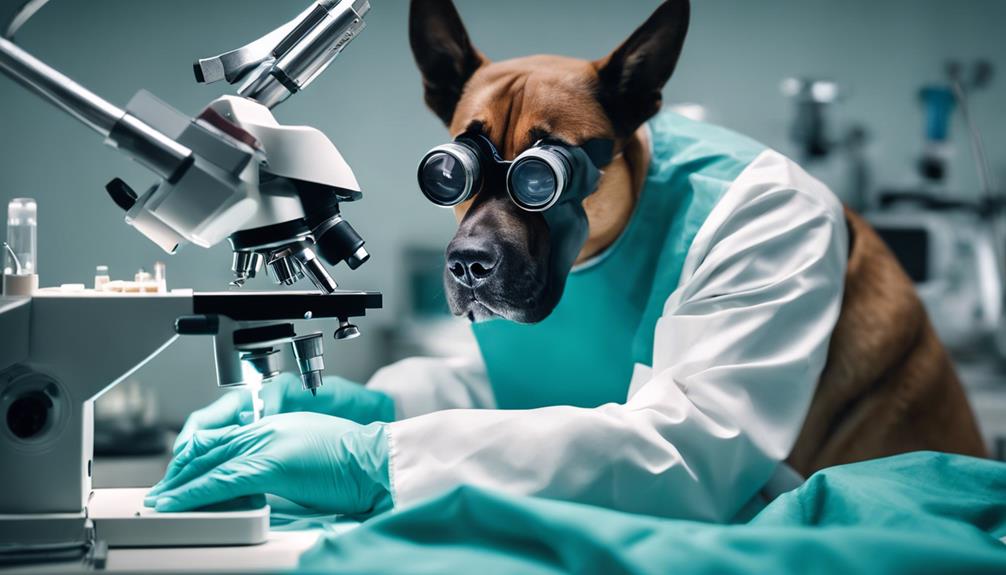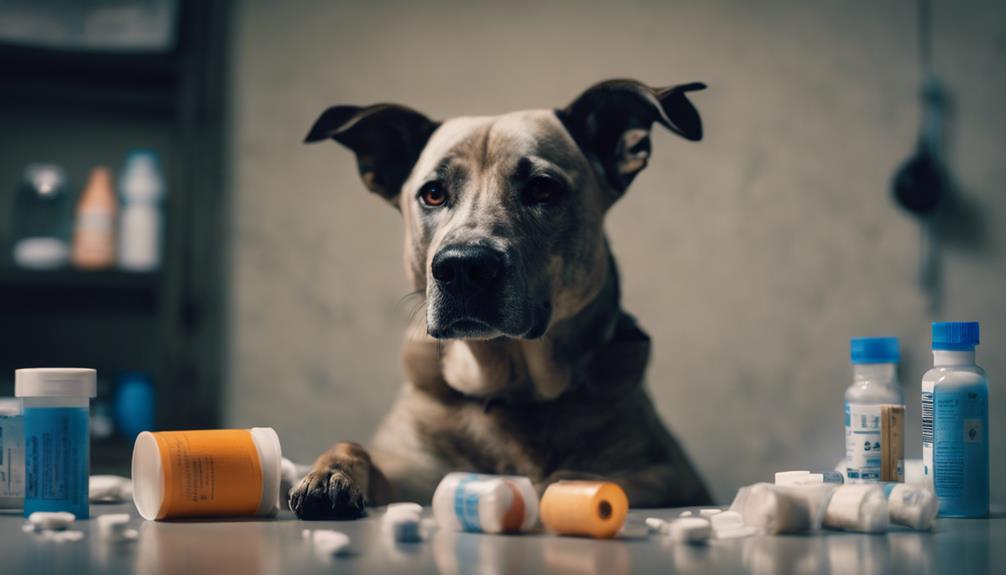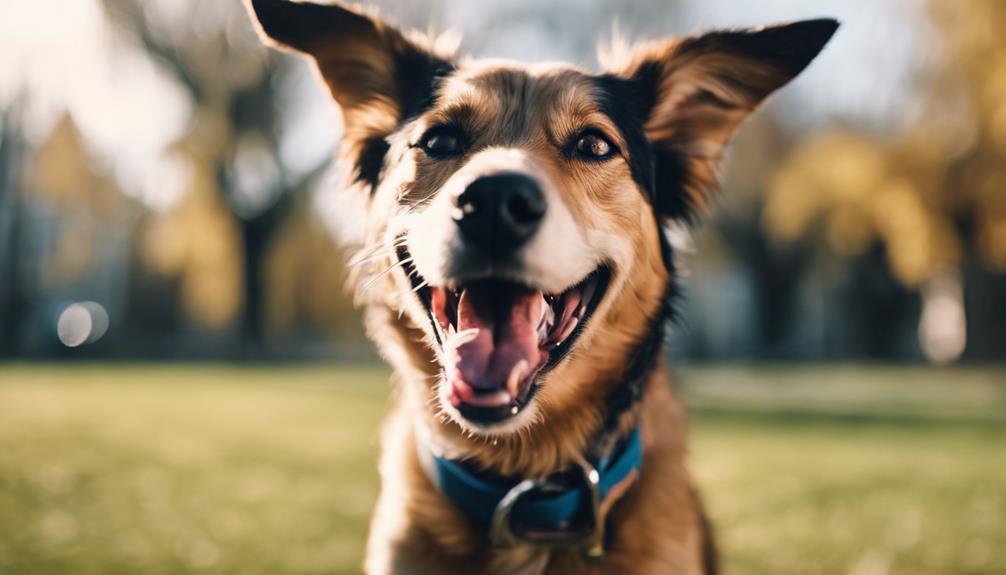What to Expect From Cataract Surgery for Dogs Recovery
- Advertisement -
When your dog undergoes cataract surgery, the recovery process is critical to prevent complications and guarantee proper healing. You'll need to carefully follow your veterinarian's post-operative instructions, including restricted activity, use of an Elizabethan collar, and administration of multiple eye drops and oral medications. Follow-up visits with your veterinarian are essential to monitor progress and detect potential complications, which can increase over time. By following these guidelines, you can help your dog recover successfully and maintain their vision. As you navigate your dog's recovery, you'll want to stay informed about what to expect and how to address any concerns that may arise.
Key Takeaways
- The dog must wear an Elizabethan collar for about two weeks to prevent eye rubbing and complications.
- Restricted activity, such as short leash walks using a harness, is necessary to minimize the risk of injury or complications.
- Multiple eye drops and oral medications will be prescribed to promote healing and prevent infection, with frequency decreasing over time.
- Regular follow-up visits with the veterinarian are essential to maintain the dog's ocular health, monitor progress, and detect potential complications.
- The owner should monitor the dog's eye for signs of complications, such as redness, discharge, or changes in vision, and report them to the veterinarian.
Understanding Cataracts and Surgery
Cataracts in dogs occur when the lens in their eye becomes cloudy, affecting their ability to see clearly. If left untreated, cataracts can cause blindness, and can affect dogs of all ages due to genetics, trauma, or metabolic issues like diabetes.
The surgical procedure to remove the cloudy lens is called phacoemulsification. It's performed under general anesthesia to ensure your dog's comfort. The process typically takes 30-60 minutes per eye, and sometimes an artificial lens is implanted to enhance vision. The surgical team uses specialized equipment and techniques to remove the cataract, aiming to restore vision and prevent complications.
The underlying cause of the cataract can affect the surgical outcome. Your veterinarian will make decisions about your dog's care to achieve the best possible results. After surgery, it's crucial to follow post-operative care instructions to prevent complications like retinal detachment and ensure a smooth recovery.
Understanding the cataract surgery process helps you provide the necessary care and attention your dog needs to regain their vision and improve their quality of life. By following your veterinarian's guidance, you can help your dog recover successfully and enjoy a better life.
Pre-Surgery Preparation and Planning
Before cataract surgery, it's essential to understand what to expect and prepare your dog accordingly. Working closely with your veterinary hospital and primary veterinarian is crucial for a successful procedure.
A pre-operative examination is necessary to identify any underlying medical conditions that could affect the surgical outcome. This examination includes diagnostic tests such as:
- Screening bloodwork
- Urinalysis
- Specialized ocular tests
These tests help identify potential issues, such as diabetes, which must be well-regulated before surgery to minimize complications. Your dog's medical history and current health status are also reviewed to determine the best course of action.
During this planning phase, you'll receive important information about the surgical procedure, post-operative care, and any necessary medications. This information is vital for a successful surgery and healthy recovery. You'll learn what to expect and how to provide the necessary care and attention to your dog's eyes during the recovery period.
The Cataract Surgery Procedure

The cataract surgery procedure involves removing the cataract and replacing it with an artificial lens to restore your dog's vision. This surgery is performed under general anesthesia to ensure your dog's comfort and safety.
To begin, the surgical team makes a small incision in the cornea to access the cataract. They then use a technique called phacoemulsification to break up and remove the cloudy lens. Next, an artificial lens, also known as an intraocular lens, is placed in the empty lens capsule to help your dog focus light.
The procedure typically takes 30-60 minutes per eye. During this time, a team member closely monitors the anesthesia and uses a mechanical ventilator to support your dog's breathing.
The goal of cataract surgery is to improve your dog's vision and reduce the risk of complications such as corneal ulcers or retinal detachments. By following your vet's instructions and undergoing post-operative care, you can help ensure a successful outcome for your dog.
Post-Surgery Care and Recovery
After cataract surgery, your dog's recovery is critical to prevent complications and ensure proper healing. To achieve this, you must follow your vet's instructions carefully.
During the initial two-week healing period, your dog will need to wear an Elizabethan collar to prevent eye rubbing. They should also have restricted activity, with short leash walks using a harness to avoid injury or complications.
Your vet will prescribe multiple eye drops and oral medications to promote healing and prevent infection. You'll need to apply these medications as directed, with the frequency decreasing over time as your dog's eyes continue to heal.
Follow-up visits with your vet are essential to maintaining your dog's ocular health and monitoring progress. The first visit usually takes place within a few days of surgery, with subsequent appointments necessary to ensure your dog's vision is progressing as expected.
During these visits, your vet will assess your dog's vision, checking for any signs of complications. By providing good post-operative care and following your vet's instructions, you can help your dog recover quickly and successfully, regaining their vision in just a few weeks.
Managing Risks and Complications

About 5% of dogs undergoing cataract surgery will experience complications. These complications can include:
- Post-operative hypertension
- Intraocular inflammation
- Lens fibre regrowth
- Glaucoma
- Retinal detachment
The most serious complications are glaucoma and retinal detachment, which can cause permanent vision loss if left untreated. Regular follow-up examinations are crucial to detect potential complications, as they can increase over time. Infection, inflammation, and vision loss are potential risks associated with cataract surgery. To minimize these risks, the surgical team takes precautions, and as the owner, you play a key role in recognizing signs of complications, such as redness, discharge, or changes in vision.
To ensure a smooth recovery, follow your vet's instructions and attend scheduled check-ups. This will enable you to address any issues promptly. Post-operative care is as important as the surgery itself in ensuring your dog's successful recovery from cataract surgery.
- Advertisement -
Success Rate and Outcome Expectations
Cataract surgery has a high success rate of around 90%. This means your dog has a good chance of regaining vision. In fact, about 95% of dogs regain vision after surgery, with some vision restored as soon as the next day. To maintain vision after surgery, it's essential to follow your vet's instructions.
The long-term prognosis is also promising. About 90% of dogs maintain their vision after one year, and 80% after two years. Following post-operative care instructions minimizes the risk of complications, which are generally low.
Cataract surgery not only restores sight but also prevents secondary issues like lens luxation. Concurrent ocular issues can decrease the success rate, but the overall outcome is still positive. By working closely with your veterinarian and following their instructions, you can expect a successful long-term outcome for your dog's vision.
Life After Cataract Surgery

After cataract surgery, your dog needs close supervision and care to ensure a successful recovery. This post-operative care is crucial for restoring their vision.
During the recovery period, remember the following:
Your dog must wear an Elizabethan collar for about two weeks to prevent eye rubbing, which can lead to complications. This collar helps protect their eye from accidental scratching or rubbing.
To minimize the risk of injury or complications, restrict your dog's activity to short leash walks using a harness. This will help prevent sudden movements that could dislodge the surgical site.
You'll need to administer multiple eye drops and topical preparations frequently, with the frequency decreasing over time. Follow the dosage and application instructions provided by your veterinarian.
Regular follow-up visits with your veterinarian are essential for maintaining your dog's ocular health and monitoring their progress. During these visits, your veterinarian will remove sutures and ensure the eye is healing properly.
Ongoing Care and Monitoring
Ongoing care and monitoring are crucial for your dog's successful rehabilitation and optimal visual outcome after eye surgery. To ensure your dog's vision returns to normal, you must follow the post-operative care instructions provided by your veterinarian. This includes administering eye drops and oral medications as directed, restricting activity, and providing a quiet space for recovery.
Regular follow-up appointments are necessary over several weeks to monitor your dog's progress, remove sutures, and adjust medication as needed. These visits allow your veterinarian to check for signs of complications, such as inflammation, glaucoma, or retinal detachments, and treat them promptly to prevent vision loss.
During these appointments, your veterinarian will assess your dog's vision to confirm they can see clearly. Regular check-ups are essential to detect potential issues early, enabling prompt medical therapy and preventing further complications. By following the recommended care and attending regular visits, you can help your dog regain their optimal vision and enjoy a better quality of life.
Frequently Asked Questions
What Is the Recovery Time for a Dog After Cataract Surgery?
After cataract surgery, your dog will need a two-week initial healing period. During this time, they'll wear an Elizabethan collar to prevent eye rubbing. To aid recovery, restrict their activity by taking them on short leash walks using a harness, and keep them in a quiet environment to minimize stress. Adhere to the provided medication schedule and attend all scheduled veterinary follow-ups to monitor visual recovery and ensure proper healing.
Will My Dog Be in Pain After Cataract Surgery?
After cataract surgery, your dog will likely experience some discomfort. To manage this, your veterinarian will provide pain relief medication to keep your dog comfortable. An eye shield is essential to prevent rubbing, which can cause further discomfort.
Your veterinarian will closely monitor your dog for signs of discomfort, such as whining or whimpering, and adjust the medication as needed to minimize side effects. This will allow your dog to focus on recovering and regaining their vision at a steady pace.
It's essential to follow your veterinarian's instructions for post-operative care to ensure your dog's comfort and prevent complications. By doing so, you can help your dog recover quickly and successfully from cataract surgery.
What to Look Out for After Dog Cataract Surgery?
After dog cataract surgery, monitor your pet for vision changes, redness, swelling, or discharge around the surgical site. Ensure your dog takes eye medications as prescribed and follows the medication schedule. Watch for post-op anxiety and use an Elizabethan collar to protect the eye. Attend follow-up appointments to track progress and remove sutures. If you notice any unusual signs, consult your veterinarian promptly to address potential complications.
Can I Take My Dog for a Walk After Cataract Surgery?
After cataract surgery, it's essential to take certain precautions when walking your dog. Initially, you'll need to keep your dog on a short leash to prevent eye injury. A gradual walking schedule will help support your dog's visual recovery.
To minimize outdoor hazards, consider blindfolding your dog or taking them to a quiet area with minimal distractions. This will help them adjust to their new surroundings.
It's also crucial to prioritize socialization and mental stimulation during this time. Try using calming aids and engaging in sedentary activities with your dog to prevent social isolation.
In summary
Cataract surgery is a crucial step towards restoring your dog's vision. To ensure a successful recovery, it's essential to provide proper care and attention. This involves following specific guidelines to help your dog heal quickly and safely.
After surgery, your dog will need time to rest and recover. You'll need to monitor their progress, manage their pain, and prevent complications. By doing so, you'll help your dog regain their clarity of vision and return to their normal activities.
Remember, every dog's recovery is different, and it's crucial to adhere to your veterinarian's specific instructions. With patience, attention, and the right care, your dog can recover from cataract surgery and enjoy a better quality of life.
- Advertisement -

